re: Tara Parker-Pope ‘Giving Chronic Pain Medical Platform of its Own’
http://community.nytimes.com/comments/well.blogs.nytimes.com/2011/07/18/giving-chronic-pain-a-medical-platform-of-its-own/
As a 34 year practicing, board certified anesthesiologist, I found the ‘ounce of prevention’ for postoperative pain in the fall of 1992.
Since I work exclusively in the world of elective cosmetic surgery, my anesthesia colleagues have been quick to dismiss my ‘nifty fifty’ paradigm shift as only being applicable to this type of surgery.
The ‘nifty fifty’ is 50 milligrams of ketamine 3 minutes prior to surgical stimulation.
In 1997, I added the BIS monitor to my propofol ketamine regimen, thereby creating a numerically reproducible level of propofol to effect to reliably prevent ketamine hallucinations.
Since that time, none of my several thousand patients have taken opioids for postoperative pain.
Disclaimer: Neither I nor my non-profit Goldilocks Anesthesia Foundation receive financial support from the makers of the BIS or other brain monitors.
Despite years of encouragement, I have not found a single academic university department of anesthesia willing to formally study this extremely simple paradigm. Shame on them.
Not until I personally received the benefit of the ‘nifty fifty’ preemptive analgesia for my total hip replacement have I been able to refute my fellow anesthesiologists’ assumption that it is only useful for cosmetic surgery.
see comment #20 to Tara Parker-Pope ‘When Pain Goes Beyond Words’
http://well.blogs.nytimes.com/2009/09/22/when-pain-goes-beyond-words/
Goldilocks anesthesia is BIS monitored propofol ketamine. Since your brain dictates the anesthesia dosage, you cannot get too much or too little, but only just the right amount.
Over the $20 sensor, don’t let anyone play Russian roulette with your brain when having surgery.
75% of US hospitals have the BIS monitor, yet it is only used 25% of the time.
Avoid routine anesthesia over medication by insisting on a brain monitor.
Download 3 free letters from www.drbarryfriedberg.com to help you get Goldilocks Anesthesia for any surgery.
